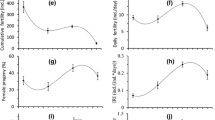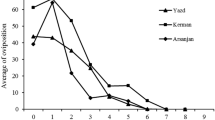Abstract
The diamondback moth, Plutella xylostella (L.) (Lepidoptera: Plutellidae), is one of the most important pests of crucifers worldwide. Susceptibility to insecticides and host plants of P. xylostella vary geographically. To investigate local adaptation, we measured the variation of the biology, life-histories and life-table parameters of P. xylostella populations from five widely ranging geographical regions in China, Beijing (BJ), Shandong (SD), Shaanxi (SX), Yunnan (YN), and Guangdong (GD), using the same variety of cabbage (Brassicae oleracea L. var. capitata; var. “Qingan 80”) as the food plant at the same temperature in the laboratory. Principal components analysis showed the life-history and life-table parameters of P. xylostella differed among the five geographical populations. The first component, including female fecundity and adult longevity and male adult longevity, accounted for the most variation among the five geographical regions, which can be classified into three groups: BJ–SX, YN–GD, and SD. The intrinsic rate of increase (r m ) was greatest in BJ and SX, intermediate for GD and YN, and the lowest for SD, whereas mean generation time (T) was greatest in SD, intermediate for YN and GD, and the lowest for BJ and SX. These variations reflect the importance of local genetic adaptation and should be considered when planning management of P. xylostella in China.






Similar content being viewed by others
References
Abdi H, Williams LJ (2010) Principal component analysis. Wiley Interdiscip Rev Comput Stat 2:433–459
Awmack CS, Leather SR (2002) Host plant quality and fecundity in herbivorous insects. Ann Rev Entomol 47:817–844
Chi H (2005) TWOSEX-MS chart: a computer program for the age-stage, two-sex life table analysis. National Chung Hsing University, Taichung, Taiwan. http://140.120.197.173/Ecology/prod02.htm
Cronin AL, Schwarz MP (1999) Latitudinal variation in the life cycle of allodapine bees (Hymenoptera; Apidae). Can J Zool 77:857–864
Furlong MJ, Wright DJ, Dosdall LM (2013) Diamondback moth ecology and management: problems, progress, and prospects. Annu Rev Entomol 58:517–541
Golizadeh A, Karim K, Fathipour Y, Abbasipour H (2007) Temperature-dependent development of diamondback moth, Plutella xylostella (Lepidoptera: Plutellidae) on two brassicaceous host plants. Insect Sci 14:309–316
Golizadeh A, Kamali K, Fathipour Y, Abbasipour H (2009) Effect of temperature on life table parameters of Plutella xylostella (Lepidoptera: Plutellidae) on two brassicaceous host plants. J Asia-Pac Entomol 12:207–212
Honěk A (1996) Geographical variation in thermal requirements for insect development. Eur J Entomol 93:303–312
Idris AB, Grafius E (1996) Effects of wild and cultivated host plants on oviposition, survival, and development of diamondback moth (Lepidoptera: Plutellidae) and its parasitoid Diadegma insulare (Hymenoptera: Ichneumonidae). Environ Entomol 25:825–833
Kocourek F, Havelka J, Berankova J, Jarosik V (1994) Effect of temperature on development rate and intrinsic rate of increase of Aphis gossypii reared on greenhouse cucumbers. Entomol Exp Appl 71:59–64
Lee CR, Mitchell-Olds T (2011) Quantifying effects of environmental and geographical factors on patterns of genetic differentiation. Mol Ecol 20:4631–4642
Liang GM, Chen W, Liu T-X (2003) Effects of three neem-based insecticides on diamondback moth (Lepidoptera: Plutellidae). Crop Prot 22:333–340
Lin XL, Pan QL, Tian HG, Douglas A, Liu T-X (2014) Bacteria abundance and diversity of different life stages of Plutella xylostella (Lepidoptera: Plutellidae), revealed by bacteria culture-dependent and PCR-DGGE methods. Insect Sci. doi:10.1111/1744-7917.12079
Liu T-X, Liu SS (2006) Experience-induced preference for a neem-based repellent by the diamondback moth, Plutella xylostella (Lepidoptera: Plutellidae). Pest Manag Sci 62:38–45
Liu S, Chen F, Zalucki MP (2002) Development and survival of the diamondback moth (Lepidoptera: Plutellidae) at constant and alternating temperatures. Environ Entomol 31:221–231
Mahmoudvand M, Abbasipour H, Garjan AS, Bandani AR (2011) Sublethal effects of hexaflumuron on development and reproduction of the Plutella xylostella (Lepidoptera: Yponomeutidae). Insect Sci 18:689–696
Maia AHN, Luiz AJB, Campanhola C (2000) Statistical inference on associated fertility life parameters using jackknife technique: computational aspects. J Econ Entomol 93:511–518
Mohan M, Gujar GT (2003a) Local variation in susceptibility of the diamondback moth, Plutella xylostella (Linnaeus) to insecticides and role of detoxification enzymes. Crop Prot 22:495–504
Mohan M, Gujar GT (2003b) Characterization and comparison of midgut proteases of Bacillus thuringiensis susceptible and resistant diamondback moth (Plutellidae: Lepidoptera). J Invertebr Pathol 83:1–11
Morrison C, Hero JM (2003) Geographic variation in life-history characteristics of amphibians: a review. J Anim Ecol 72:270–279
Ni XZ, Xu WW, Blanco MH, Wilson JP (2012) Evaluation of corn germplasm lines for multiple ear-colonizing insect and disease resistance. J Econ Entomol 105:1457–1464
Niu YQ, Li XW, Li P, Liu TX (2013) Effects of different cruciferous crops on the fitness of Plutella xylostella (Lepidoptera: Plutellidae). Crop Prot 54:100–105
Niu YQ, Sun YX, Liu TX (2014) Development and reproductive potential of diamondback moth (Lepidoptera: Plutellidae) on selected wild crucifer species. Environ Entomol 43:69–74
Rotem K, Agrawal AA, Kott L (2003) Parental effects in Pieris rapae in response to variation in food quality: adaptive plasticity across generations? Ecol Entomol 28:211–218
Saeed R, Sayyed AH, Shad SA, Zaka SM (2010) Effect of different host plants on the fitness of diamondback moth, Plutella xylostella (Lepidoptera: Plutellidae). Crop Prot 29:178–182
Sarfraz M, Dosdall LM, Keddie BA (2006) Diamondback moth–host plant interactions: implications for pest management. Crop Prot 25:625–639
Sarnthoy O, Keinmeesuke P, Sinchaisri N, Nakasuji F (1989) Development and reproductive rate of the diamondback moth, Plutella xylostella from Thailand. Appl Entomol Zool 24:202–208
SAS Institute (2003) SAS® system (version 9.1) for Windows®. SAS Institute, Cary
Shelton AM, Cooley RJ, Kroening MK, Wilsey WT, Eigenbrode SD (1991) Comparative analysis of two rearing procedures for diamondback moth, Plutella xylostella (Lepidoptera: Plutellidae). J Entomol Sci 26:17–26
Shirai Y (2000) Temperature tolerance of the Plutella xylostella (Lepidoptera: Yponomeutidae) in tropical and temperate regions of Asia. Bull Entomol Res 90:357–364
Southwood TRE, Henderson PA (2009) Ecological methods, 3rd edn. Methuen, London
Tang JD, Shelton AM, van Rie J, de Roeck S, Moar WJ, Roush RT, Peferoen M (1996) Toxicity of Bacillus thuringiensis spore and crystal protein to resistant diamondback moth (Plutella xylostella). Appl Environ Microbiol 62:564–569
Umeya KYH (1973) Threshold temperature and thermal constants for development of the diamond-back moth, Plutella xylostella L., with reference to their local differences. Appl Entomol Zool 17:19–24
van Lenteren JC, Noldus LPJJ (1990) Whitefly–plant relationships: behavioural and ecological aspects. In: Gerling D (ed) Whiteflies: their bionomics, pest status and management. Intercept Andover, England, pp 47–49
Zhang PJ, Lu YB, Zalucki MP, Liu SS (2012) Relationship between adult oviposition preference and larval performance of the diamondback moth, Plutella xylostella. J Pest Sci 85:247–252
Acknowledgments
The authors greatly appreciate F. Zhang (Beijing Academy of Agricultural and Forestry Sciences, Beijing), K.Y. Wang (Shandong Agricultural University, Taian, Shandong, China), Z.Y. Li (Institute of Plant Protection, Guangdong Academy of Agriculture Science, Guangdong, China), and A.D. Chen (Institute of Agricultural Environment and Resources, Yunnan Academy of Agricultural Sciences, Kunming, Yunnan, China) for providing the diamondback moths used in this study. We sincerely thank Professor John L. Koprowski (Wildlife and Fisheries Science, School of Natural Resources and the Environment, University of Arizona, Tucson) for review of an earlier version of this manuscript. This work was partially supported by the National Basic Research Program of Ministry of Science and Technology, China (973 Program, 2012CB114105), the Special Fund for Agro-Scientific Research in the Public Interest (201303019), and China Agriculture Research System (CARS-25-B-06). We are grateful for the assistance of all staff and students in the Key Laboratory of Applied Entomology, Northwest A&F University at Yangling, Shaanxi, China. TXL and QJP designed the experiment; QJP, LC and XLL conducted experiments; QJP, TJRS and TXL analyzed data. QJP, TXL and TJRS wrote the manuscript. All authors read and approved the manuscript.
Author information
Authors and Affiliations
Corresponding author
Additional information
Communicated by J. J. Duan.
Rights and permissions
About this article
Cite this article
Pan, QJ., Chen, L., Lin, XL. et al. Geographical variations in life histories of Plutella xylostella in China. J Pest Sci 87, 659–670 (2014). https://doi.org/10.1007/s10340-014-0608-0
Received:
Revised:
Accepted:
Published:
Issue Date:
DOI: https://doi.org/10.1007/s10340-014-0608-0




